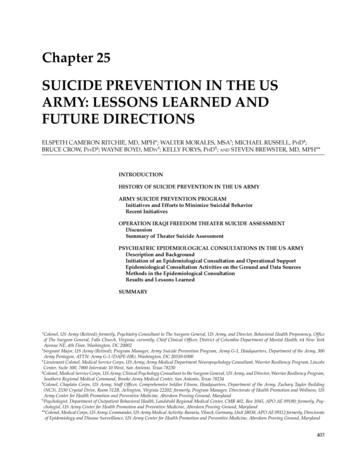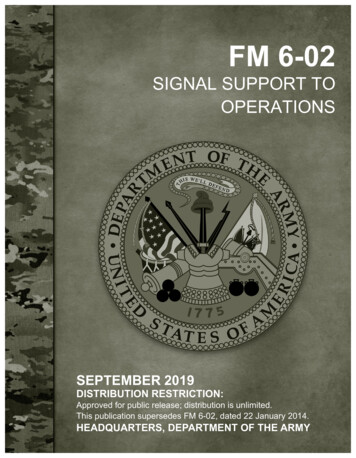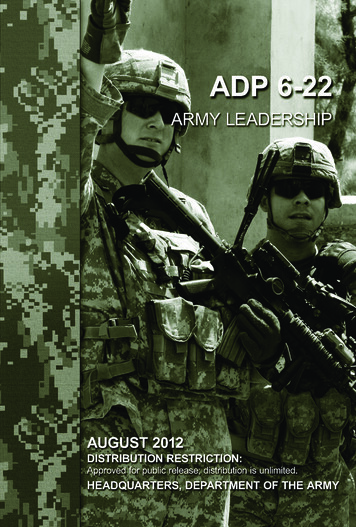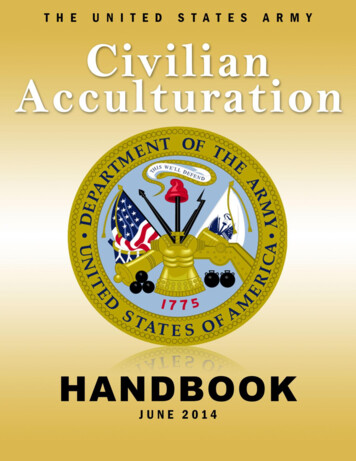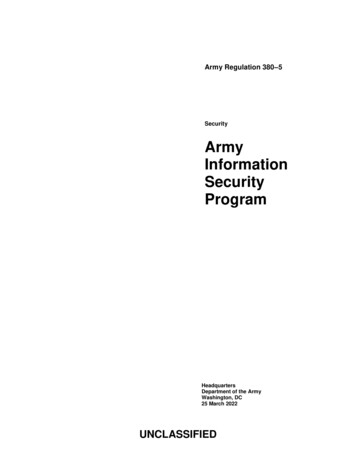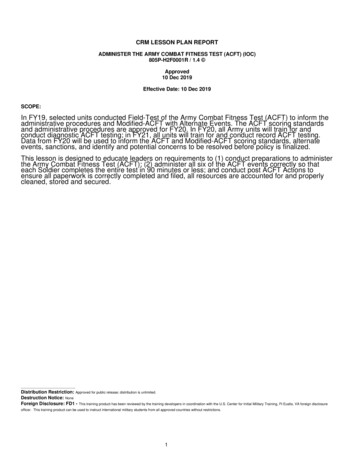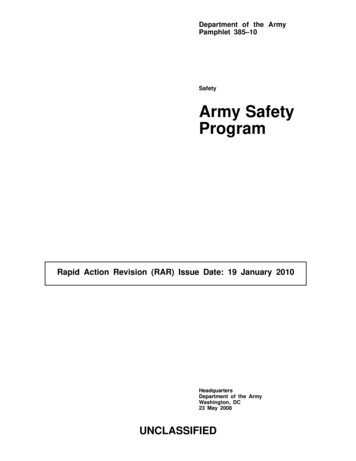
Transcription
Department of the ArmyPamphlet 385–10SafetyArmy SafetyProgramRapid Action Revision (RAR) Issue Date: 19 January 2010HeadquartersDepartment of the ArmyWashington, DC23 May 2008UNCLASSIFIED
SUMMARY of CHANGEDA PAM 385–10Army Safety ProgramThis rapid action revision, dated 19 January 2010-o Establishes time line uniformity on awards as 15 December of eachyear (paras 6-3a(4), 6-3b(4), 6-3c(4), and 6-3h(4)).o Adds procedures on the Army Safety Excellence Streamer (para 64e).o Makes additional rapid action revision changes (chap 12).
*Department of the ArmyPamphlet 385–10HeadquartersDepartment of the ArmyWashington, DC23 May 2008SafetyArmy Safety ProgramApplicability. This pamphlet appliesto the Active Army, the Army National Guard/Army National Guard ofthe United States, and the U.S. ArmyReserve, unless otherwise stated. Italso applies to Army civilian employees and the U.S. Army Corps of Engineers and Civil Works activities andtenants and volunteers in accordancewith Section 1588, Title 10, UnitedStates Code and AR 608–1.Proponent and exception authority.History. This publication is a rapidaction revision (RAR). This RAR iseffective 19 February 2010. Theportions affected by this RAR arelisted in the summary of change.Summary. This pamphlet prescribesArmy policy on safety and occupational health issues. It implements thesafety requirements of AR 385–10and other Federal regulations andlaws.ContentsThe proponent for this pamphlet isthe Chief of Staff, Army. The proponent has the authority to approve exceptions or waivers to this pamphletthat are consistent with controllinglaw and regulations. The proponentmay delegate this approval authority,in writing, to a division chief withinthe proponent agency or its directreporting unit or field operating agency, in the grade of colonel or the civilian equivalent. Activities mayrequest a waiver to this pamphlet byproviding justification that includes afull analysis of the expected benefitsand must include formal review bythe activity’s senior legal officer. Allwaiver requests will be endorsed bythe commander or senior leader of therequesting activity and forwardedthrough their higher headquarters tothe policy proponent. Refer to AR 2530 for specific guidance.Suggested improvements. Users areinvited to send comments and suggested improvements on DA Form2028 (Recommended Changes toPublications and Blank Forms)directly to the Director of ArmySafety (DASAF), 223 23rd St., Room980, Arlington, VA 22202.Distribution. This publication isavailable in electronic media only andis intended for command levels A, B,C, D, and E for the Active Army, theArmy National Guard/Army NationalGuard of the United States, and theU.S. Army Reserve.(Listed by paragraph and page number)Chapter 1General, page 1Introduction 1–1, page 1References 1–2, page 1Explanation of abbreviations and terms 1–3, page 1Functions 1–4, page 1Objectives 1–5, page 1Funding 1–6, page 1Chapter 2Goals and Strategic Planning, page 1Introduction 2–1, page 1Establishing appropriate safety goals 2–2, page 2*This pamphlet supersedes DA Pam 385–10, dated 24 August 2007. This edition publishes a rapid action revision of DA Pam 385–10.DA PAM 385–10 23 May 2008/RAR 19 January 2010UNCLASSIFIEDi
Contents—ContinuedDeveloping a strategic safety plan 2–3, page 2Resources 2–4, page 2Review and evaluation 2–5, page 2Chapter 3Army Safety Program Structure, page 3Introduction 3–1, page 3Safety and occupational health manager 3–2, page 3Tailoring the safety organization 3–3, page 3Safety staff functions 3–4, page 5Safety labor categories 3–5, page 5Interface with other organizations 3–6, page 7Chapter 4Contracting Safety, page 7Introduction 4–1, page 7Safety and Occupational Health Program 4–2, page 7Contractual requirements for products, services, and system development and fielding 4–3, page 8Contractual requirements for construction 4–4, page 9Chapter 5Public, Volunteer, Family, and Recreational Safety, page 10Introduction 5–1, page 10Family safety plans 5–2, page 11Volunteer safety 5–3, page 11Public safety 5–4, page 11Recreational safety 5–5, page 11Other activity recreational safety 5–6, page 13Chapter 6Army Accident Prevention Awards Program, page 14Introduction 6–1, page 14Procedures 6–2, page 14Department of the Army level unit awards 6–3, page 14Army headquarters and organization level awards 6–4, page 20Chapter 7Safety Training Requirements, page 21General 7–1, page 21Safety professional training 7–2, page 22Safety training for non-safety professionals 7–3, page 22Chapter 8Safety and Occupational Health Hazard Identification and Abatement, page 23Introduction 8–1, page 23Workplace inspection and safety and occupational health programs/assessments/inspections/reporting 8–2, page 23Standards 8–3, page 24Army employee hazard reporting 8–4, page 25Abatement plan/tracking corrective actions 8–5, page 26Department of Labor/Occupational Safety and Health Administration inspections 8–6, page 27Chapter 9Standing Operating Procedures for Hazardous Operations, page 28Introduction 9–1, page 28Purpose 9–2, page 28Applicability 9–3, page 28iiDA PAM 385–10 23 May 2008
Contents—ContinuedStanding operating procedure requirements 9–4, page 28Standard operating procedure developers 9–5, page 28Writing the standard operating procedure 9–6, page 28Review-concurrence 9–7, page 29Review date 9–8, page 29Supervisor statement 9–9, page 29Operator/task performer statement 9–10, page 30Accessibility of standing operating procedures 9–11, page 30Standing operating procedure index 9–12, page 30Confirmation of use 9–13, page 30Chapter 10Emergency Planning, page 30Introduction 10–1, page 30Functions 10–2, page 30Elements of emergency planning 10–3, page 31Coordination 10–4, page 32Chapter 11Emergency Response for Conventional Munitions and Explosives, page 32General 11–1, page 32Pre-event planning 11–2, page 33Functions 11–3, page 33Emergency response 11–4, page 34Response procedures 11–5, page 34Public affairs and security 11–6, page 35Accident site clean up 11–7, page 35Accident investigation 11–8, page 35Munitions/explosives accident reporting 11–9, page 36Training 11–10, page 36Chapter 12Operations Safety Around Water, page 36Introduction 12–1, page 36Water safety procedures 12–2, page 37Water safety equipment 12–3, page 37Marine operations pre-event planning 12–4, page 37Chapter 13Facility Closure, page 38General 13–1, page 38Legal and regulatory responsibilities 13–2, page 38Hazardous waste 13–3, page 38Unexploded ordnance 13–4, page 39Radiation sources 13–5, page 40Other warfighting materials 13–6, page 40Chapter 14Workplace Safety Programs, page 40Introduction 14–1, page 40Hazard Communication Program 14–2, page 40Lockout/tagout 14–3, page 41Confined spaces 14–4, page 42Fall protection 14–5, page 46Bloodborne pathogen 14–6, page 50DA PAM 385–10 23 May 2008iii
Contents—ContinuedErgonomics 14–7, page 52Material handling 14–8, page 55AppendixesA.References, page 56B.Safety Training Available from U.S. Army Center for Health Promotion and Preventive Medicine, page 59C.Training Programs, page 59D.Standard Army Safety and Occupational Health Inspections Mandatory Procedures, page 65E.Department of Defense Safety and Occupational Health Program, page 67F.Notice of Unsafe or Unhealthful Working Conditions, page 69G. Violation Inventory Log, page 71H.Alleged Unsafe or Unhealthful Working Conditions, page 73I.Installation Hazard Abatement Plan, page 75J.Safety and Occupational Health Program Sub-functions/Tasks/Cost Drivers, page 77Table ListTable 3–1: Safety professional job functions and qualifications, page 6Table 14–1: Safety net extension, page 50Table C–1: Exposure based training matrix for all employees (including managers, supervisors, regular, contract,temporary, summer and long-term leave employees, and employees promoted or transferred), page 60Table C–2: Exposure based training matrix for managers/supervisors, page 60Table C–3: Exposure based training matrix for affected employee groups, page 61Table C–4: Exposure based training matrix for maintenance and facilities personnel, page 64Table C–5: Exposure based training matrix for emergency preparedness and response personnel, page 64Table J–1: Sub-functions definitions and cost drivers, page 77Table J–2: Sub-functions and Tasks, page 78Table J–3: Installation support core sub-functions/tasks, page 82Figure ��1: Standard core safety structure, page 5E–1: Sample DD Form 2272, Department of Defense Safety and Occupational Health Protection Program,68F–1: Sample DA Form 4753, Notice of Unsafe or Unhealthful Working Conditions, page 70G–1: Sample DA Form 4754, Violation Inventory Log, page 72H–1: Sample DA Form 4755, Employee Report of Alleged Unsafe or Unhealthful Working Conditions,74I–1: Sample DA Form 4756, Installation Hazard Abatement Plan, page 76GlossaryivDA PAM 385–10 23 May 2008
Chapter 1General1–1. IntroductionThroughout this pamphlet, the term “command” includes Army Commands (ACOMs), Army Service ComponentCommands (ASCCs), Direct Reporting Units (DRUs), National Guard Bureau (NGB), Field Operating Agencies, andStaff Supporting Agencies.a. This pamphlet establishes mandatory guidance, functions, policies and procedures for the Army’s Safety Program.The goal of this pamphlet and subsequent programs is to reduce the risk of death or injury to Soldiers and civilians,and damage to vehicles, equipment and property due to accidents.b. This pamphlet also establishes requirements for safety and accident prevention programs on Army installations,provides guidance concerning public health and safety laws and regulations, and establishes procedures for compliancewith the safety requirements of AR 385–10 and other Army safety and occupational health regulations. This pamphletis compatible with other Army safety and occupational health pamphlets.c. This pamphlet is organized to provide detailed guidance for selected chapters of AR 385–10. Each section of thispamphlet corresponds with a similar section of the regulation. When a chapter of AR 385–10 is not included in thispamphlet, that chapter has a unique pamphlet that was written to specifically address that topic.1–2. ReferencesRequired and related publications and prescribed and referenced forms are listed in appendix A.1–3. Explanation of abbreviations and termsAbbreviations and special terms used in this pamphlet are explained in the glossary.1–4. FunctionsArmy Safety Program functions required of Army organizations are addressed in AR 385–10.1–5. ObjectivesThis pamphlet provides guidance on how to implement improved safety procedures and processes for the subject areasincluded in this pamphlet. This pamphlet provides guidance in recognizing units and individuals that make outstandingcontributions to accident prevention efforts and acts. Through the implementation of this pamphlet, the safety andhealth of Army personnel, dependents and surrounding community will be improved.1–6. FundingEach organization will include funding at the level required for full implementation of the Army Safety Program, theArmy Accident Prevention Awards Program and other requirements of this pamphlet in their budget submissions.Chapter 2Goals and Strategic Planning2–1. Introductiona. The first step in developing and implementing a vigorous safety program is to identify strategic goals and theplans required to achieve those goals, as required in AR 385–10, chapter 2.b. Goals for safety must be part of the command/organization’s mission objectives. Safety goals will support overallcommand objectives by helping keep personnel safe and ready for duty. Through strategic planning each organization,from Headquarters Department of the Army (HQDA) to ACOMs to the lowest level can determine what its goals forsafety should be, and how best to achieve these goals.c. Strategic planning and goal setting has several benefits.(1) First, by establishing realistic goals and the plan(s) to achieve these goals the entire organization is oriented inthe same direction. Disjointed operations, actions that do not contribute to plan implementation and goal achievementare controlled and eliminated, reducing waste of limited personnel and resources on nonproductive operations.(2) Second, the process of establishing goals and strategic plans is positive since it should bring together allelements of the command/organization. Through working together to identify what is necessary for the command/organization to support Army safety goals and the associated plans, each element has improved understanding of itsrole in safety and occupational health and how each is essential to promoting overall objectives.(3) Third, by determining the overall strategy, the allocation of resources can be more efficiently managed.Personnel and programs can be applied to those areas with the greatest return.DA PAM 385–10 23 May 20081
2–2. Establishing appropriate safety goalsSafety goals are established by determining the requirements placed on the command/organization by higher-levelorganizations (that is, Army goals), internal requirements, and what is needed to serve customers (for example, othercommands and organizations). Therefore, effective goals to achieve safe operations will be focused on the organization’s mission.a. The Strategic Safety Plan (SSP) will use the Strategic Readiness Score Card (SRS) System used by the DeputyChief of Staff, G–3/5/7 (DCS, G–3/5/7) to ensure that safety goals and objectives are consistent with the Army’s goalsthat have been established by the Chief of Staff Army (CSA).(1) Safety goals will be prioritized to align the highest priority goals with regulatory requirements and with Armygoals.(2) Goals that directly affect the safety of personnel and directly support mission requirements will receive higherpriorities.b. Goals that are attuned to an organization’s mission, vision, goals, and capabilities are not set in a vacuum. Just assafety is the responsibility of all Army personnel (for example, military, civilians) so is the setting of goals forachieving safe operations, training, and non-duty activities. Safety goals are not set just by the safety office. Eachorganization within a command should be a full participant in the process. The commander will lead the effort with thesafety professional serving as advisor and administrator.c. Each organization within the command will provide input to the safety goal setting process. A safety council/committee, established by the commander and chaired by the commander or his/her Chief of Staff will have representation from organizations/units throughout the command. Tenant organizations and the Army community should also berepresented.d. Goals for safety will be as simply stated as possible. Goals will focus on the issue being addressed withoutexcessive and confusing language, being as specific as possible. All goals will have a target date established. Byestablishing a target date, emphasis is placed on actions to meet the date. Long-term goals should be set high,establishing requirements that are probably beyond immediate achievement, but that can be achieved within a specifiedperiod.e. Goals must be measurable. This is required for management to determine if progress is being made toward thegoal.(1) Safety goals will not contradict each other, or the mission of the command and other goals that may have beenestablished.(2) Goals will always be stated in a positive manner. Positively worded goals place the attention of the command onwhat is to be accomplished, not on what has gone poorly in the past.(3) Finally, goals will be directed toward achieving a desired outcome. The goal will support Army readiness byreducing Soldier loss due to accidents, thereby maintaining Soldier and unit readiness.f. Goals must be approved by the commander and the chain of command and promulgated throughout the command.Every person in the command, and when appropriate dependents and contractors will be aware of the goals and theirrole in achieving each goal. The Safety Office will document the strategic goals and clarifying information, includingminutes of meetings and summaries of documents as required.2–3. Developing a strategic safety plana. Goals will not be achieved without a strategic plan that sets forth the process for each goal. SSPs are developedthe same way that goals are developed, through command action and the involvement of all elements of the command.Each goal will include how the goal will be accomplished. To ensure that a plan is developed that is integrated with theArmy operational cycle, planning for the SSP will align with the fiscal year/budget cycle.(1) Safety goals and SSPs will be developed for the current fiscal year and the next four years of the budget cycle.(2) One result of the planning process will be identification of funding and personnel requirements to support theplan and goals and preparation of the budget documentation.b. Senior members of the command, representing all command elements will participate in developing the SSP.2–4. ResourcesLeaders, commanders, managers, and supervisors are responsible for ensuring organization SSPs are identified andincorporated into each commands budget and personnel requirements documents to support Army safety goals.2–5. Review and evaluationThe commander will ensure that the SSP is implemented. This will be accomplished by ensuring that there are actionplans (or work plans) for each goal and area of the plan. Specific tasks will be assigned, milestones established andtracked, and progress will be regularly reported to the commander.a. Resource utilization will be part of the reporting process to verify that funds are being applied in a timely andefficient manner to the appropriate tasks. On a quarterly basis, or more frequently if required by the complexity of theplan or as determined by the commander, progress in achieving goals will be reviewed by the commander.2DA PAM 385–10 23 May 2008
b. Any shortfalls in what is required, as identified in the budget and other documents, will be documented alongwith the projected impact of the shortfall on achievement of safety goals. When safety goals that seriously affectoverall Army goals are being breached, the status, reason for the shortcoming, and recommended corrective action willbe forwarded to the next level of command.Chapter 3Army Safety Program Structure3–1. IntroductionAn effective safety program requires a safety organizational structure that is capable of implementing Federal,Department of Defense (DOD), ACOMs, installation level, and organizational safety and occupational health (SOH)standards as well as any other requirements to reduce accidental risk to our resources. While each command mustorganize their safety program to suit the requirements of that command, each safety organization must meet therequirements of this pamphlet.3–2. Safety and occupational health managera. The SOH director is the primary person responsible for planning, developing, coordinating, evaluating, andproviding technical consultation for assuring implementation of the command’s safety program. The SOH director willmeet all requirements of Part 1960, Title 29, Code of Federal Regulations (29 CFR 1960) and DODI 6055.1.b. As a member of the commander’s personal staff, the safety director will—(1) Make independent assessments to assist organizations within the command in integrating Federal, DOD, Army,and organizational requirements to reduce risk of accidental losses.(2) Have unimpeded access to senior commander to reporting status of safety program and provide safety technicalassistance directly to the commander.c. Advise, plan, develop, coordinate, and evaluate the safety program by providing the following functions:(1) Reports and gives advice to the commander on SOH issues/policy. Assists all elements of the command in theimplementation of the SSP in implementing their specific tasks.(2) Assists all elements of the command in the implementation of the SSP in implementing their specific tasks.(3) Manages and provides technical oversight of the safety program, including identifying the metrics that bestmeasure progress on implementing the SSP and achieving the command’s safety goals.(4) Develops policy and procedures for integration of SOH, composite risk management (CRM), and accidentprevention activities of the command.3–3. Tailoring the safety organizationa. The safety organization functions are an extension of the commander in the area of SOH.b. The safety organization will include a qualified SOH Director and safety staffs that meet the requirements of CFR29, 1960 Federal Employee Occupational Safety and Health Program.c. The safety organization is responsible for five core safety functional and sub-functional areas (see app J fordetailed task of each sub-function) to assist commanders in mission sustainment.(1) Safety program management.(a) Work place safety (Occupational Safety and Health Administration (OSHA)).(b) System safety.(c) Radiation safety.(d) Range safety.(e) Tactical safety.(f) Explosive safety.(g) Chemical agent safety.(h) Doctrine and leadership development.(2) Inspection/assessments.(3) Accident investigation/reporting.(4) Promotion and awareness.(5) Hazard analysis and countermeasures.d. Each functional area is administered by a qualified SOH professional qualified in the functional and subfunctional area. In smaller commands/organizations the safety office may have fewer personnel. In these offices, theformal structure must reflect the multiple duties that are performed by each individual.(1) In addition to performing core safety functions and sub-functions Army safety professionals will perform uniqueDA PAM 385–10 23 May 20083
safety functions, sub-functions, and tasks that will support leader’s efforts in integrating safety and composite riskmanagement in organizations missions (see app J).(2) U.S. Army Installation Management Command (IMCOM) safety professionals will focus on sub-functions andtask that support integrating safety and risk management in installation support operations (for example, reviewoperational procedures of facility engineers to ensure safety and CRM in daily operations, and/or provide safetysupport for installation recreational infrastructure).(3) U.S. Army Training and Doctrine Command (TRADOC) safety professionals will focus on sub-functions andtask that support integrating safety and CRM in doctrine, training and leadership development (for example, review andintegrate safety tactics and procedures in Army school curriculums and doctrine).(4) U.S. Army Forces Command (FORSCOM) safety professionals will focus on sub-functions and task thatintegrate safety and CRM concepts in tactical operations (for example, review the operation plan (OPLAN) and coursesof actions to ensure safety and risk management procedures are apart of mission analysis per FM 5–19).e. The organization chart at figure 3–1 is the standard Army Safety Office Organization. This chart is structured toshow the standard safety organization that is required when a command/installation has a mission that encompasses livefiring ranges, military and civilian workforce with nonmilitary unique operations, explosive and radiation operations.The mission of the command and any installation tenants determines which functions are required in the safetyorganization. The magnitude of the mission also influences whether a particular function is required as a separatebranch reporting to the SOH director or if the function can be incorporated in another branch or in the situation ofsmaller organizations, consolidated into the duties of one person not normally requiring a separate branch in the safetyoffice structure.f. In addition to the standard safety organization structure identified in figure 3–1, there is also a requirement foractivity safety personnel who perform the safety duty as “other duty as assigned role”. This individual should bereferred to as the Additional Duty Safety Officer (ADSO) or Collateral Duty Safety Officer (CDSO). This usuallyoccurs in activities where the table of organization and equipment/table of distribution and allowance/modified table oforganization and equipment (TOE/TDA/MTOE) based on required functions/task does not support a full time safetyofficer. The person designated as the ADSO/CDSO will be of sufficient rank to perform these duties normally acommissioned officer/warrant officer at Battalion or higher unit levels; staff sergeant at company or detachment levels;or a Department of the Army (DA) civilian as needed. The person selected must have at least 12 months remainingwith the unit after appointment. The appointment will be confirmed in orders designating the unit safety officer byname. The unit safety officer will have received, or will receive training for this position as soon as possible, but nolater than 3 months after being appointed the specific area.g. Safety councils/committee are established at each level of command and chaired by commander (see DA Pam385–1 for procedures).4DA PAM 385–10 23 May 2008
Figure 3–1. Standard core safety structure3–4. Safety staff functionsThe standard organizational structural depicted in figure 3–1 provides sub-functional areas. Details for sub-functions,tasks, and cost drivers are located in appendix J. All safety organizations will consist of the five core sub-functions.3–5. Safety labor categoriesThe Army has established a civilian Safety Career Program (CP) designated as CP–12. The standards for the civilianSafety Career Program are defined in The Safety Management Career Field Management Guide, which is published athttp://cpol.army.mil.library. Note. Training requirements, career progression and other useful information is containedin this document.a. Career field 12, Safety and Occupational Health Career Program includes—(1) GS–0018, Safety and Occupational Health Management.(2) GS–0803, Safety Engineer.(3) GS–1306, Health Physicist.(4) GS–1815, Air Safety Investigator.(5) GS–0690, Industrial Hygienist.(6) The functional chief (FC) is the Deputy Assistant Secretary of the Army (Environment, Safety and OccupationalHealth), DASA (ESOH). The Office of Personnel Management has established standards for these labor categories.These standards may be found at the Army Civilian Personnel and Office of Personnel Management Web sites,respectively.b. Each labor category is summarized in the table 3–1; however, the most current standards and requirements mustbe obtained from the referenced Web site.DA PAM 385–10 23 May 20085
Table 3–1Safety professional job functions and strial Hygienists(0690)Duties are to advise on, administer, supervise, manage,or perform professional and scientific work in industrialhygiene, including the identification and evaluation ofconditions affecting the health and efficiency of employees, or the citizens of the adjacent community, the formulation and recommendation of measures to eliminateor control occupational health hazards, and the promotion of occupational health programs for instructing andmotivating managers and employees in the preventionas well as correction of potential health hazards.An industrial hygienist normally holds a degree in engineering, chemistry, or physics or a degree in a closelyrelated biological or physical science from an accreditedcollege or university.Safety and Occupational HealthManager(0018)Duties involve the management, administration, or operation of a safety and occupational health program orperformance of administrative work concerned withsafety and occupational health activities and includesthe development, implementation and evaluation of related program functions. The primary objective of thiswork is the elimination or minimization of human injuryand property and productivity losses caused by harmfulcontact incidents, through the design of effective management policies, programs or practices. Safety andoccupational health management work requires application of the knowledge of: (1) the principles, standards, and techniques of safety and occupational healthmanagement; and (2) pertinent elements of engineering, physical science, ergonomics, psychology, industrial hygiene, physiology, sociology, and other scientificand technological fields, that contribute to the achievement of comprehensive safety and occupational healthobjectives.College degree in an appropriate discipline with relevantexperience at the senior management level. Must have abroad knowledge of applicable state and Federal regulations. A practical knowledge of the methods, techniques,and procedures apply by industrial hygienists and environmental and fire prevention engineers is frequentlynecessary. Should possess safety and occupationalhealth program knowledge, skills, and abilities. Safetyand occupational health managers and specialists shouldhave a working knowledge of subject-matter areas suchas information systems, fiscal, personnel and propertymanagement and the social and physical sciences. Theidentification and solution of many safety and occupational health problems often requires cooperation with individuals from these fields.Safety Engineering(0803)Applies scientific and engineering principles and methods to the elimination and control of hazards resultingfrom human error, and equipment and machine operations that may lead to injury to persons and damage toproperty. Safety engineers need to know a lot aboutmany different fields. They specialize in recognition andcontrol of hazards and they work closely with other engineering and non-engineering disciplinesThe position requires training in engineering or scientificprinciples and a
Contents—Continued Ergonomics † 14-7, page 52 Material handling † 14-8, page 55 Appendixes A. References, page 56 B. Safety Training Available from U.S. Army Center for Health Promotion and Preventive Medicine, page 59 C. Training Programs, page 59 D. Standard Army Safety and Occupational Health Inspections Mandatory Procedures, page 65 E. Department of Defense Safety and .



